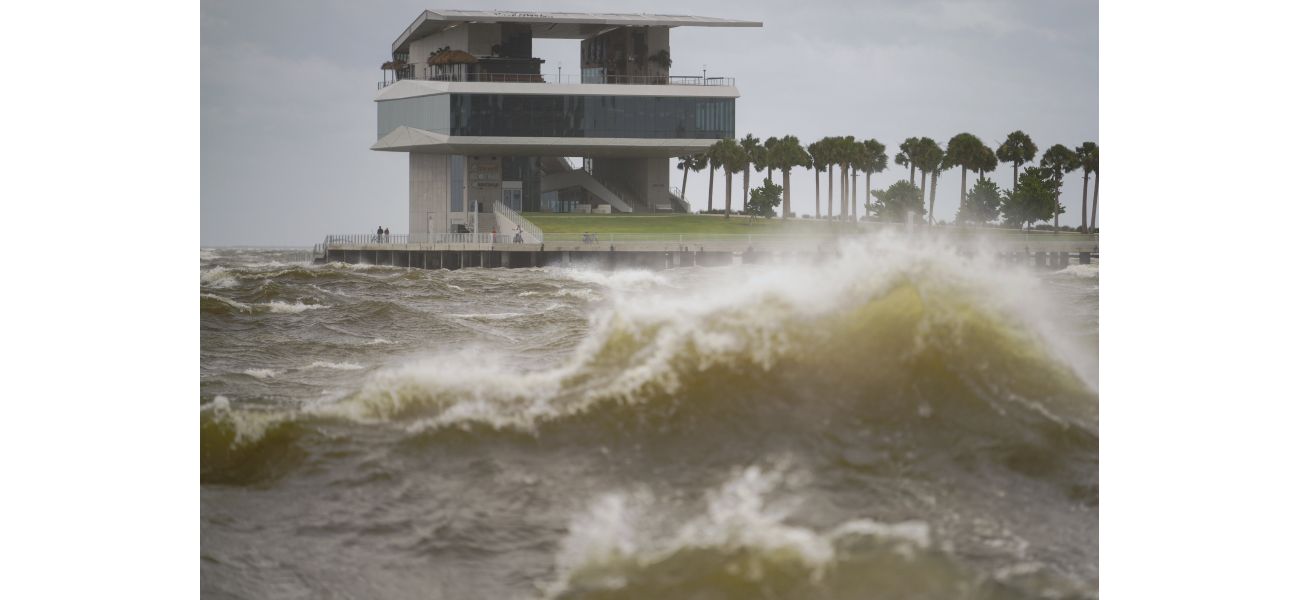Hurricane Helene reaches Category 4 strength and hits northwestern Florida.
Power outages affect over 250,000 properties as states declare emergencies due to strong winds.
September 27th 2024.

The state of Florida was hit with a powerful hurricane, named Helene, on Thursday evening. The storm, classified as a Category 4, made landfall in the Big Bend area of the state's northwestern coast. Forecasters warned of the potential for catastrophic storm surges, strong winds, and heavy rains that could cause flash floods across the southeastern United States.
As Helene approached, authorities in Georgia reported two deaths possibly caused by a tornado. In addition, Florida Governor Ron DeSantis announced that one person died while driving on Interstate 4 when a sign fell onto their car. The hurricane also caused power outages, leaving over 1 million homes and businesses in Florida and over 50,000 in Georgia without electricity.
States of emergency were declared in Florida, Georgia, the Carolinas, Virginia, and Alabama. The situation was equally dire in the Pacific, where former Hurricane John regained strength on Thursday morning and threatened Mexico's western coast with flooding and mudslides. Though it was later downgraded to a tropical storm, John continued to pose a threat as it moved along the Mexican state of Michoacan.
Meanwhile, a new storm, named Isaac, formed in the Atlantic Ocean on Wednesday. Forecasters predicted that it would strengthen as it moved away from the United States, possibly becoming a hurricane by the end of the week.
Governor DeSantis expressed concern for the safety of Florida residents, urging them to take precautions and stay indoors during the storm. He also warned that there may be more fatalities as Helene continues to move through the state. The governor announced that 3,500 National Guardsmen were ready to assist with any necessary response efforts.
As of late Thursday evening, Helene had made landfall in northwestern Florida, with maximum sustained winds of 140 mph. Forecasters warned of potential storm surges up to 20 feet in the Apalachee Bay area, which could be catastrophic and unsurvivable. In addition to hurricane warnings, flash flood warnings were also issued for areas far beyond the coast, extending into northern Georgia and western North Carolina.
Power outages continued to rise throughout the state of Florida, with over 885,000 customers without electricity as of 11 p.m. EDT. The majority of these outages were concentrated in the Big Bend area, where Helene made landfall.
Meanwhile, in the Pacific, former Hurricane John was downgraded to a tropical storm as it moved slowly along Mexico's coast. Despite the downgrade, the storm still posed a threat with sustained winds of 70 mph and the potential for severe flash flooding. John initially hit Mexico on Monday as a Category 3 hurricane, causing damage and destruction before weakening inland. However, it regained strength and was reclassified as a hurricane on Thursday.
The US National Hurricane Centre predicted that John would continue to weaken as it moved along the coast, and eventually dissipate by Friday. The storm has caused significant damage and disruption, with reports of tin roofs being blown off houses and landslides occurring in affected areas.
As the hurricane season continues, it is important for those in potentially affected areas to stay informed and prepare for potential storms. Stay safe and follow any evacuation orders or precautions issued by local authorities.
The residents of Florida's northwestern coast braced themselves as Hurricane Helene, a fast-moving Category 4 storm, made landfall in the Big Bend area on Thursday evening. The forecasters warned of potential catastrophic consequences, including a dangerous storm surge, powerful winds, and flash floods that could reach hundreds of miles inland throughout the southeastern United States.
As Helene approached, the state of Georgia reported two fatalities, believed to be caused by a tornado, and Florida Governor Ron DeSantis confirmed one death as a result of a fallen sign on Interstate 4. The storm also caused power outages for over a million homes and businesses in Florida and over 50,000 in Georgia. The situation was being closely monitored by poweroutage.us, a tracking site that provided updates on the power outages.
The severity of the situation prompted states of emergency to be declared in Florida, Georgia, the Carolinas, Virginia, and Alabama. In addition to Helene, the Pacific was also facing a potential threat as former Hurricane John regained strength and was downgraded to a tropical storm. The storm was expected to bring flash flooding and mudslides to the western coast of Mexico.
Meanwhile, in the Atlantic Ocean, Tropical Storm Isaac had formed and was predicted to intensify as it moved away from the United States. There was a possibility that it could become a hurricane by the end of the week, according to the forecasters.
Gov. DeSantis expressed his concern for the safety of his constituents, stating that the dangerous conditions were evident with the tragic death on Interstate 4. He urged people to stay indoors and take necessary precautions, as more fatalities and property damage were expected. The governor also mentioned that 3,500 National Guardsmen were on standby to assist with the storm's aftermath.
Helene officially made landfall near Perry, Florida, in the Big Bend area, with maximum sustained winds of 140 mph. The National Hurricane Centre warned of potential storm surges up to 20 feet, which could be devastating for Florida's Apalachee Bay area. The hurricane and flash flood warnings extended far beyond the coast, covering northern Georgia and western North Carolina.
As Helene continued to make its way through Florida, power outages continued to increase, leaving over 885,000 customers without electricity. The majority of these outages were concentrated in the Big Bend area, where Helene was expected to hit the hardest.
In the Pacific, former Hurricane John was downgraded to a tropical storm as it slowly moved along the coast of the Mexican state of Michoacan. Despite the downgrade, the storm still posed a threat with sustained winds of 70 mph and the potential for severe flash flooding. John had initially made landfall in Acapulco as a Category 3 hurricane, causing significant damage before regaining strength and turning back into a hurricane.
The forecasters predicted that John would weaken as it moved further inland, providing some relief to the affected areas. However, the situation was being closely monitored, and precautions were being taken to ensure the safety of those in its path.
In conclusion, Hurricane Helene and former Hurricane John posed a significant threat to the southeastern United States and Mexico, respectively. The governors of the affected states urged their residents to take precautions and stay safe as the storms continued to pass through. The situation was being closely monitored, and the forecasters provided regular updates to keep everyone informed.
As Helene approached, authorities in Georgia reported two deaths possibly caused by a tornado. In addition, Florida Governor Ron DeSantis announced that one person died while driving on Interstate 4 when a sign fell onto their car. The hurricane also caused power outages, leaving over 1 million homes and businesses in Florida and over 50,000 in Georgia without electricity.
States of emergency were declared in Florida, Georgia, the Carolinas, Virginia, and Alabama. The situation was equally dire in the Pacific, where former Hurricane John regained strength on Thursday morning and threatened Mexico's western coast with flooding and mudslides. Though it was later downgraded to a tropical storm, John continued to pose a threat as it moved along the Mexican state of Michoacan.
Meanwhile, a new storm, named Isaac, formed in the Atlantic Ocean on Wednesday. Forecasters predicted that it would strengthen as it moved away from the United States, possibly becoming a hurricane by the end of the week.
Governor DeSantis expressed concern for the safety of Florida residents, urging them to take precautions and stay indoors during the storm. He also warned that there may be more fatalities as Helene continues to move through the state. The governor announced that 3,500 National Guardsmen were ready to assist with any necessary response efforts.
As of late Thursday evening, Helene had made landfall in northwestern Florida, with maximum sustained winds of 140 mph. Forecasters warned of potential storm surges up to 20 feet in the Apalachee Bay area, which could be catastrophic and unsurvivable. In addition to hurricane warnings, flash flood warnings were also issued for areas far beyond the coast, extending into northern Georgia and western North Carolina.
Power outages continued to rise throughout the state of Florida, with over 885,000 customers without electricity as of 11 p.m. EDT. The majority of these outages were concentrated in the Big Bend area, where Helene made landfall.
Meanwhile, in the Pacific, former Hurricane John was downgraded to a tropical storm as it moved slowly along Mexico's coast. Despite the downgrade, the storm still posed a threat with sustained winds of 70 mph and the potential for severe flash flooding. John initially hit Mexico on Monday as a Category 3 hurricane, causing damage and destruction before weakening inland. However, it regained strength and was reclassified as a hurricane on Thursday.
The US National Hurricane Centre predicted that John would continue to weaken as it moved along the coast, and eventually dissipate by Friday. The storm has caused significant damage and disruption, with reports of tin roofs being blown off houses and landslides occurring in affected areas.
As the hurricane season continues, it is important for those in potentially affected areas to stay informed and prepare for potential storms. Stay safe and follow any evacuation orders or precautions issued by local authorities.
The residents of Florida's northwestern coast braced themselves as Hurricane Helene, a fast-moving Category 4 storm, made landfall in the Big Bend area on Thursday evening. The forecasters warned of potential catastrophic consequences, including a dangerous storm surge, powerful winds, and flash floods that could reach hundreds of miles inland throughout the southeastern United States.
As Helene approached, the state of Georgia reported two fatalities, believed to be caused by a tornado, and Florida Governor Ron DeSantis confirmed one death as a result of a fallen sign on Interstate 4. The storm also caused power outages for over a million homes and businesses in Florida and over 50,000 in Georgia. The situation was being closely monitored by poweroutage.us, a tracking site that provided updates on the power outages.
The severity of the situation prompted states of emergency to be declared in Florida, Georgia, the Carolinas, Virginia, and Alabama. In addition to Helene, the Pacific was also facing a potential threat as former Hurricane John regained strength and was downgraded to a tropical storm. The storm was expected to bring flash flooding and mudslides to the western coast of Mexico.
Meanwhile, in the Atlantic Ocean, Tropical Storm Isaac had formed and was predicted to intensify as it moved away from the United States. There was a possibility that it could become a hurricane by the end of the week, according to the forecasters.
Gov. DeSantis expressed his concern for the safety of his constituents, stating that the dangerous conditions were evident with the tragic death on Interstate 4. He urged people to stay indoors and take necessary precautions, as more fatalities and property damage were expected. The governor also mentioned that 3,500 National Guardsmen were on standby to assist with the storm's aftermath.
Helene officially made landfall near Perry, Florida, in the Big Bend area, with maximum sustained winds of 140 mph. The National Hurricane Centre warned of potential storm surges up to 20 feet, which could be devastating for Florida's Apalachee Bay area. The hurricane and flash flood warnings extended far beyond the coast, covering northern Georgia and western North Carolina.
As Helene continued to make its way through Florida, power outages continued to increase, leaving over 885,000 customers without electricity. The majority of these outages were concentrated in the Big Bend area, where Helene was expected to hit the hardest.
In the Pacific, former Hurricane John was downgraded to a tropical storm as it slowly moved along the coast of the Mexican state of Michoacan. Despite the downgrade, the storm still posed a threat with sustained winds of 70 mph and the potential for severe flash flooding. John had initially made landfall in Acapulco as a Category 3 hurricane, causing significant damage before regaining strength and turning back into a hurricane.
The forecasters predicted that John would weaken as it moved further inland, providing some relief to the affected areas. However, the situation was being closely monitored, and precautions were being taken to ensure the safety of those in its path.
In conclusion, Hurricane Helene and former Hurricane John posed a significant threat to the southeastern United States and Mexico, respectively. The governors of the affected states urged their residents to take precautions and stay safe as the storms continued to pass through. The situation was being closely monitored, and the forecasters provided regular updates to keep everyone informed.
[This article has been trending online recently and has been generated with AI. Your feed is customized.]
[Generative AI is experimental.]
0
0
Submit Comment





